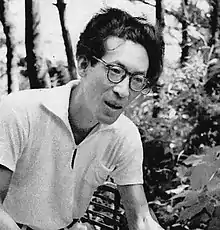Yoshie Hotta | |
|---|---|
 Yoshie Hotta in 1954 | |
| Born | 17 July 1918 Takaoka, Toyama Prefecture, Japan |
| Died | 5 September 1998 (aged 80) |
| Occupation | Writer |
| Nationality | Japanese |
| Alma mater | Keio University |
Yoshie Hotta (堀田善衛, Hotta Yoshie, July 17, 1918 – September 5, 1998)[1] was a Japanese writer of novels, short stories, poetry and essays, noted for his political consciousness.[2] His most acclaimed works include Hiroba no kōdoku (lit. "Solitude in the Public Square", 1951), which was awarded the Akutagawa Prize, and Kage no bubun (Shadow Pieces, 1952).[1][2] Hotta has also been associated with the Atomic bomb literature genre.[3]
Biography
A graduate from Keio University, Hotta already published poems and essays in the literary journal Hihyō during his student years.[4] He experienced the end of the Pacific War in Shanghai, where he stayed for two years to write for the Chinese Nationalist Party before returning to Japan in 1947.[1] His early works centered on Japan's recent history, thematising events like the bombing of Hiroshima (in Kage no bubun, 1952, or Shimpan, 1963) or the Nanjing Massacre (in Jikan, 1955),[5] and life in Japan during the early post-war years.[2] Later, he turned his attention also to International relationships and history, attending meetings of the Afro-Asian Writers' Association and writing books about historic figures like Goya, Montaigne and François de La Rochefoucauld.[1][6][7]
Selected works
- 1951: Hiroba no kōdoku
- 1952: Kage no bubun (Shadow Pieces)
- 1952: Kankan
- 1952: Rekishi
- 1955: Jikan
- 1957: Indo de kangaeta koto
- 1963: Shimpan (Judgment)
- 1971: Hōjōki shiki
- 1974–77: Goya
- 1991–94: Misheru jōkan no hito
- 1998: Ra Roshufūkō kōshaku densetsu
Awards
- 1951: Akutagawa Prize for Hiroba no kōdoku
- 1971: Mainichi Publishing Culture Award for Hōjōki shiki
- 1977: Jirō Osaragi Prize for Goya
- 1977: Lotus Prize for Literature
- 1994: Asahi Prize
- 1998: Japan Art Academy Prize for Literature
Adaptations
Hiroba no kōdoku was adapted into a film in 1953, written by Katsuhito Inomata and directed by and starring Shin Saburi.[8]
Together with Shin'ichirō Nakamura and Takehiko Fukunaga, Hotta wrote the original story which was later adapted into the kaiju film Mothra, first published in Asahi Shimbun.[9][10]
Bibliography
- Hotta, Yoshie (1994). Judgment. Translated by Tsukui, Nobuko. Osaka: Kansai Gaidai University.
- Rimer, J. Thomas; Gessel, Van C. (2007). "Hotta Yoshie (includes one translated chapter of Kage no bubun)". The Columbia Anthology of Modern Japanese Literature: From 1945 to the present. Columbia University Press. ISBN 9780231138048.
- O'Neill, P.G. (2001). "Shadow Pieces (Kage no bubun)". Collected Writings of P.G. O'Neill: The Collected Writings of Modern Western Scholars on Japan. Vol. 4. Tokyo: Japan Library and Edition Synapse. ISBN 1-873410-50-6.
References
- 1 2 3 4 "堀田善衛 (Hotta Yoshie)". Kotobank (in Japanese). Retrieved 28 August 2021.
- 1 2 3 Rimer, J. Thomas; Gessel, Van C. (2007). The Columbia Anthology of Modern Japanese Literature: From 1945 to the present. Columbia University Press. p. 107. ISBN 9780231138048.
- ↑ "原爆文学 (Atomic bomb literature)". Kotobank (in Japanese). Retrieved 28 August 2021.
- ↑ Miller, J. Scott (2010). The A to Z of Modern Japanese Literature and Theater. Scarecrow Press. p. 37. ISBN 9780810876156.
- ↑ "Heftarchiv – Autoren: Hotta, Yoshie". Sinn und Form (in German). Retrieved 28 August 2021.
- ↑ Katō, Shūichi (1997). A History of Japanese Literature: From the Man'yōshū to Modern Times. Japan Library. p. 347.
- ↑ "Hotta Yoshie Bunko". Deutsches Institut für Japanstudien (in German). Retrieved 28 August 2021.
- ↑ "広場の孤独 (Hiroba no kōdoku)". Kinenote (in Japanese). Retrieved 29 August 2021.
- ↑ "モスラ (Mosura)". Kinenote (in Japanese). Retrieved 29 August 2021.
- ↑ Galbraith IV, Stuart (2008). The Toho Studios Story: A History and Complete Filmography. Scarecrow Press. pp. 183–184. ISBN 978-1461673743.